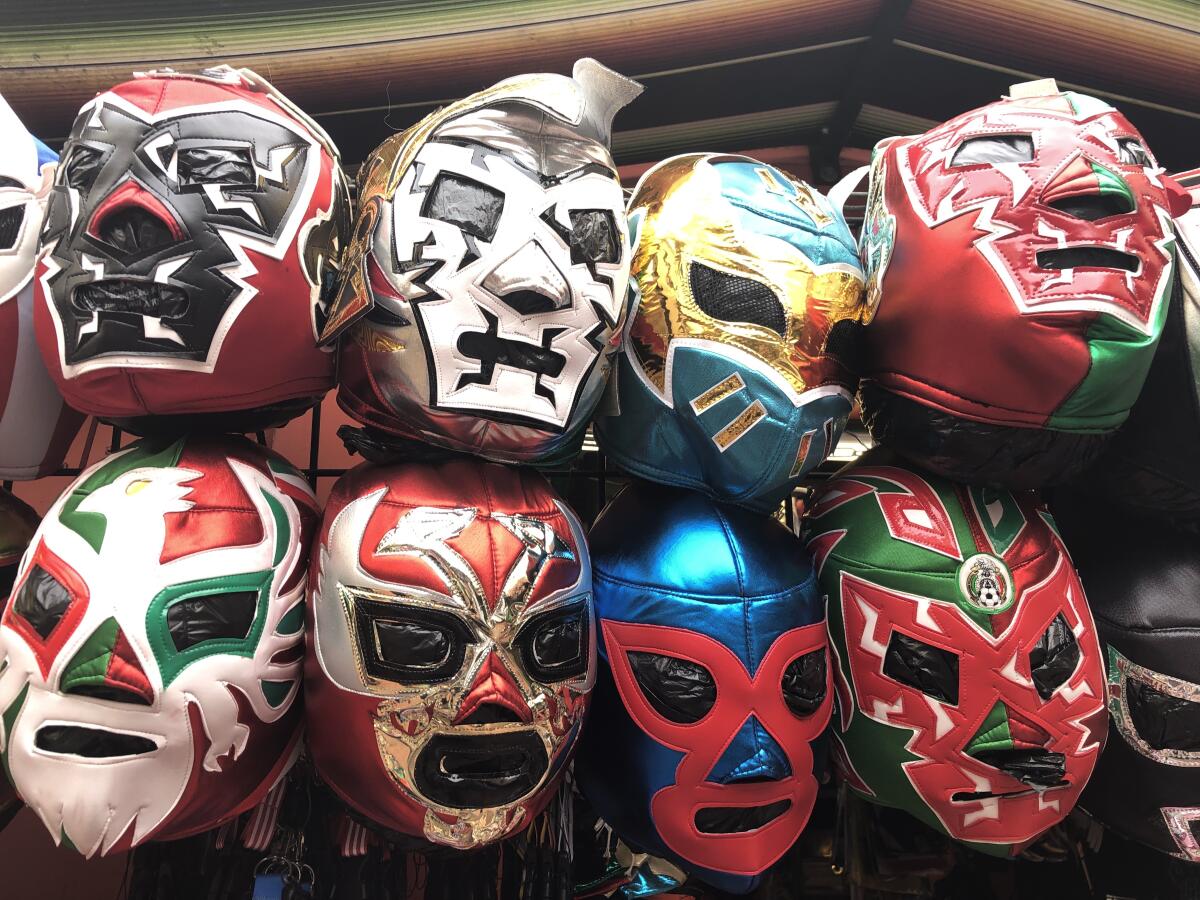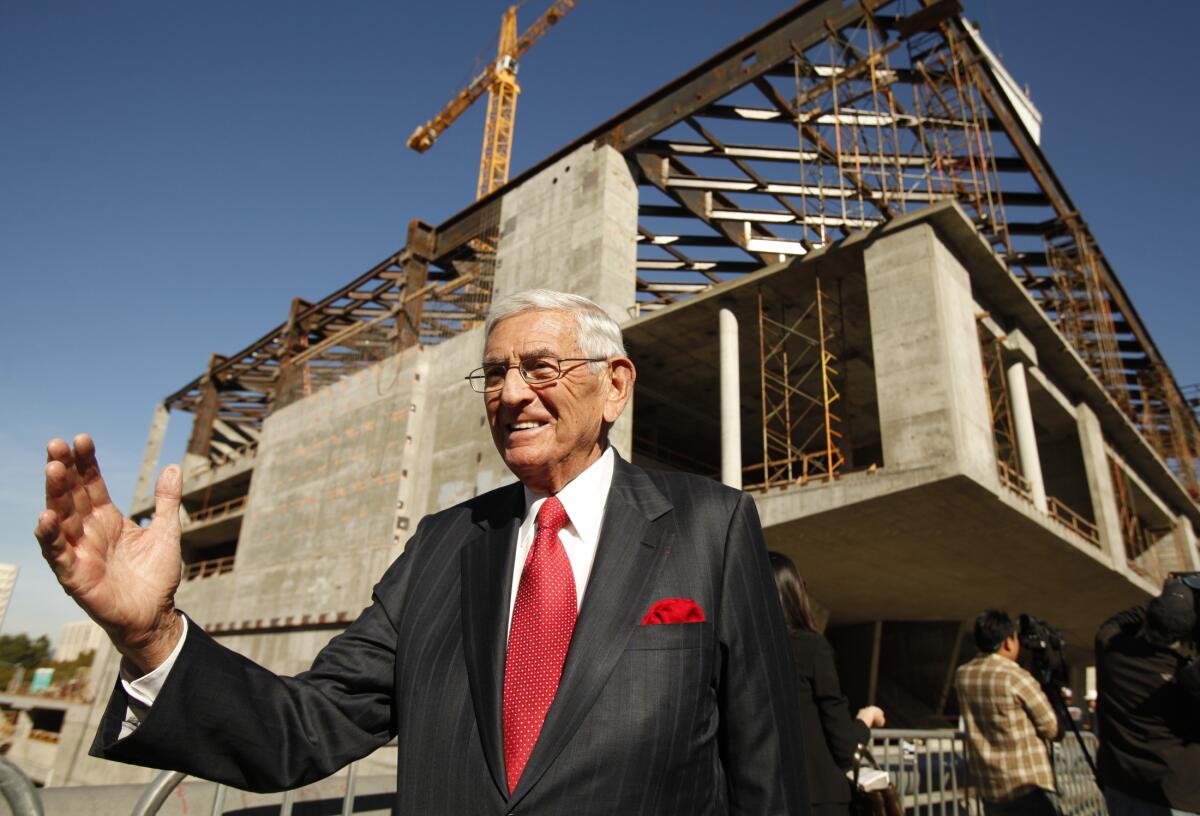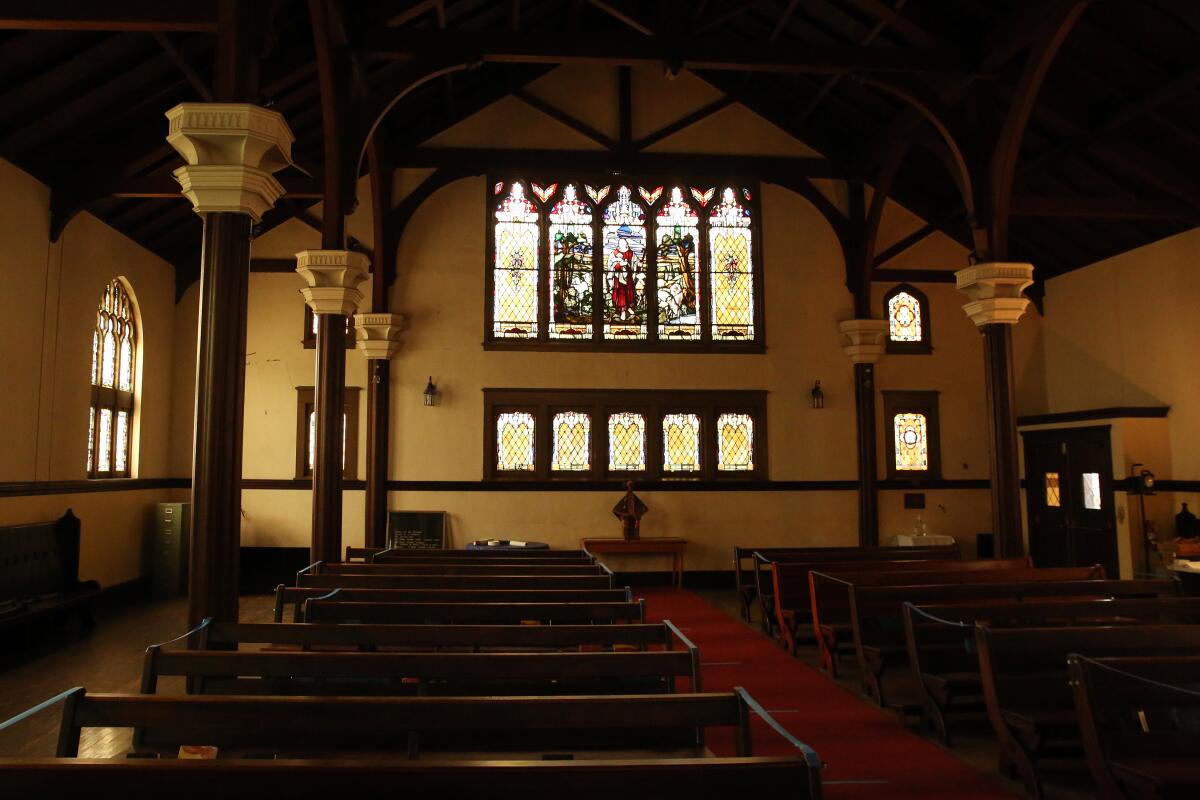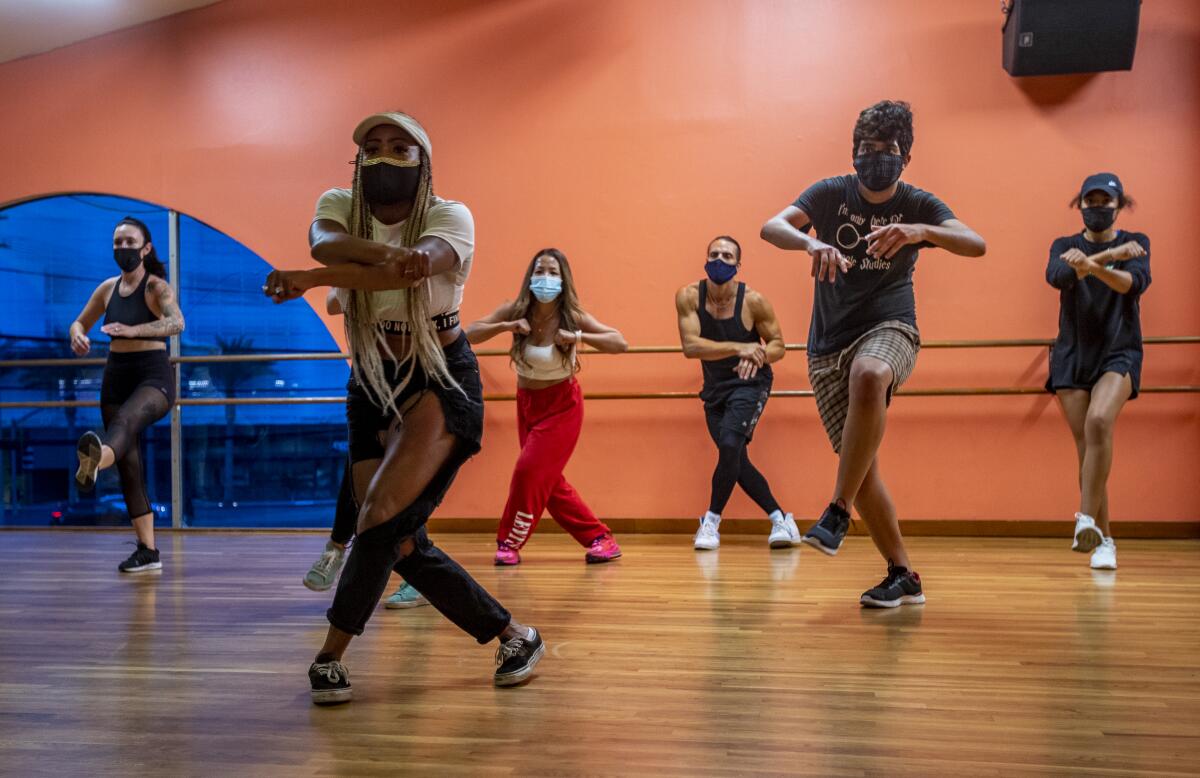Newsletter: Essential Arts: A largely Latino-free Oscars in L.A.’s Mexican heart

- Share via
I’m Carolina A. Miranda, arts and urban design columnist at the Los Angeles Times, and it’s the weekend — which means it’s time for the week’s essential culture news:
The award goes to ... the security fence
On Sunday, as a cavalcade of late-model SUVs were beginning to pull into Union Station to deliver a clutch of Hollywood types who didn’t include Scott Rudin to the 93rd Academy Awards, I went to have a look at how the shutdowns might be affecting one of L.A.’s most important transit areas. With 90 minutes to showtime, transit within the station was generally running smoothly, as passengers moved between Amtrak and Metro rail lines. Though, as my colleague Jessica Gelt reported, Godspeed to anyone looking for the public COVID-testing site, which was hidden in a small alcove by Metro’s headquarters.
The exterior of Union Station, however, was another story.
Alameda Street was completely blocked off to traffic, as was the whole western side of the station, requiring all passengers who wanted to access any transit to walk east through a traffic tunnel on Cesar Chavez Avenue. Thankfully, the city had thoughtfully cleaned up the tunnel in anticipation of all the pedestrian activity ... ha ha, just kidding. That’s the fantasy Hollywood ending. Instead, the tunnel sidewalk was Jackson Pollocked with a patch of dried vomit, and a staircase at Cesar and Clara Street was laden with poop.
Moreover, a security fence blocked off access to much of the plaza and to Father Serra Park, which frequently serves as a refuge to homeless Angelenos. On Sunday, however, any evidence of their presence was all gone. As photojournalist Jeremy Lindenfield pointed out on Twitter, “If you remember one thing from last night’s #oscars it should be that Los Angeles displaced an unhoused community so that they could pretend to care about them by giving a movie about unhoused people best picture.”
Make the most of L.A.
Get our guide to events and happenings in the SoCal arts scene. In your inbox every Monday and Friday morning.
You may occasionally receive promotional content from the Los Angeles Times.
What was particularly poignant about wandering around the neighborhood at the Oscar hour is that the industry that seems perpetually unable to actually nominate any Latino on-screen talent had taken over L.A.’s Mexican heart like an occupying army.
Not that this mattered to the denizens of Olvera Street, across from Union Station, where things on Sunday were business as usual — or whatever business as usual is when you’re in a pandemic orange tier. The cumbia dance party that generally takes place in the plaza on Sunday afternoons, and draws a mix of Latino families, was still going down by the security fence. Mr. Churro was dispensing fresh churros. The line at Cielito Lindo was eight deep.

You could also pick up a Raiders poncho, a luchador mask and T-shirts that pay tribute to Taylor Hackford’s 1993 epic Chicano drama “Blood In, Blood Out,” the cult hit that made a bunya tree in Boyle Heights internationally famous. (Memo to Buena Vista Home Video: Please make the film available to stream already.)
Ultimately, the scene that played out in L.A.’s historic core on Sunday was a perfect urban metaphor for Hollywood exclusion: Latino life kept obscured by a well-shrouded security fence.
L.A. loses a patron
Eli Broad, the billionaire philanthropist and art collector who helped shape L.A.’s cultural landscape and played a key role in the building of institutions such as MOCA and Disney Hall, died Friday afternoon at the age of 87. Though an important booster of key cultural institutions, he could also wield his power controversially.
In the obituary for The Times, Elaine Woo writes: “Calling himself a ‘venture philanthropist,’ he expected his benefaction to bring more than a pat on the back and naming rights. He regarded his donations as investments, the success of which he would judge by their returns, whether in the form of scientific breakthroughs, improved test scores or higher museum attendance.”

Times art critic Christopher Knight considers his complicated legacy as an arts patron: “Eli came by his name recognition for good and for ill. Instrumental in helping Los Angeles become one of the most prominent cities internationally for contemporary art, he was also a bull in the newly emerging china shop of L.A. museums.”
I look at Broad’s legacy in the world of architecture: the kind of patron who was “important by virtue of his wealth and his power; if not always a determination to get the design right.”
Preserving L.A.’s landmarks
“Save the Cinerama Dome! That’s been the rallying cry since news broke that the ArcLight Cinemas and Pacific Theatres, long shuttered by the pandemic, were closing up shop for good,” writes my colleague Nita Lelyveld, about the famed 1963 building housing one of L.A.’s most iconic theaters. But as she notes, it might be a good idea to “spread this same preservation passion” to other L.A. sites.

Speaking of memory: Times reporter Julia Wick spoke with L.A.’s chief design officer (and former Times architecture critic) Christopher Hawthorne, about “Past Due,” a new 166-page report issued by the city’s Civic Memory Working Group, which looks at how L.A. might go about memorializing its history. Says Hawthorne: “Both the racial and social justice protests and the pandemic reflected a need for us to understand our history more clearly — particularly the parts of our history that we’ve tried to put aside.”
Plus, Daniel Tures writes an essay about visiting L.A.’s old Nike missile sites.
Foos on the blockchain
My colleague Daniel Hernandez dives into the NFT craze with a story about how figures such as Mister Cartoon, known for his tattoo and graffiti designs, and King Foo, the secretive founder of social media’s Foos Gone Wild, are getting into the game. (FTR: A “foo,” writes Hernandez, is “short for fool,” a slang term that is “rarely written but often uttered, for a certain kind of harmless West Coast vato archetype. Picture shaved heads, white tees, knee-high socks and a love for ‘kicking it.’”) A GIF of a character called Little Mister E, created by King Foo and the digital artist and designer known as Eddie Visual, recently sold for more than $42,000 on the Foundation platform to a collector in Dubai.
Plus, an NFT linked to a drawing by Jean-Michel Basquiat is withdrawn after the artist’s estate intervenes.
Since we’re talking about the internet: Absolutely, positively do not miss this story by Zach Mortice at Bloomberg CityLab about an online architectural conspiracy theory focused on “a globe-spanning civilization called the Tartarian Empire, which was somehow erased from the history books.”
Plus, I got one word and one word only and it’s “cheugy.”
Plays and players
April marks the anniversary of William Shakespeare’s birthday and Times theater critic Charles McNulty pays tribute with an essay about why his work remains resonant centuries later: “Shakespeare’s characters keep drawing us back because we want to understand them more fully. They leave us with an impression of unfinished business. Just as no one in our lives can be fully known, so the figures in his plays reveal only so much about what they think, feel and believe.”
Enjoying this newsletter? Consider subscribing to the Los Angeles Times
Your support helps us deliver the news that matters most. Become a subscriber.
The fallout from reports over film and theater producer Scott Rudin’s abusive behavior toward his colleagues continues. Rudin has resigned from the powerful Broadway League, a trade association for theaters and producers.
Plus, The Times’ Ashley Lee reports that Rudin is no longer the producer for the touring production of “To Kill a Mockingbird.” It remains unclear, she writes, “whether the loss of a producer title means that Rudin no longer has a financial stake in the ‘To Kill a Mockingbird’ national tour.” The tour was originally set to play at L.A.’s Ahmanson Theatre, but due to pandemic-related rescheduling is no longer on the lineup, though it could still land at the Hollywood Pantages or the Dolby.
Lee also reports that “The Great Gatsby” is being turned into a musical and Florence Welch of Florence + the Machine will serve as lyricist and composer. “Musicals were my first love,” she stated, “and I feel a deep connection to Fitzgerald’s broken romanticism.”

Contributing reviewer Margaret Gray went to check out Tom Dugan’s “The Ghosts of Mary Lincoln” a show that took place in Dugan’s backyard — and one in which the towering Dugan plays the petite former first lady. Somehow, it works, writes Gray: “Any disbelief I might have been harboring got up and left, entirely on its own, no suspension required.”
Art after coronavirus
The Heritage Square Museum in Highland Park was the site of a momentous performing arts happening last weekend: the first major musical or theatrical performance to be staged in Los Angeles in 14 months (if you don’t count drive-in events). Times classical music critic Mark Swed, naturally, was there. For the show, Pacific Opera Project staged Leonard Bernstein’s “Trouble in Tahiti” on the museum’s lawn, a nod to the first production POP put on a decade ago. That version was not so hot, writes Swed. The production from Sunday, however, “was mature, deeply affecting, solidly professional opera” — despite a host of pandemic provisions.
L.A. dance studios were devastated by the pandemic. Now they are making a slow comeback. But, as The Times’ Makeda Easter reports, “owners say the path toward stability will be arduous, even as coronavirus cases fall and vaccination rates increase.” L.A. may soon be entering the yellow tier, which would allow dance studios to reopen at 50% capacity, with the possibility of a full reopening occurring in June. A full recovery, however, will be far more challenging: “The last year has been ‘horrific’ for dance, said Allegra Clegg, director of Westside School of Ballet.”

The San Francisco Symphony is returning to in-person concerts in May.
Black heroes
For much of the 20th century, depictions of Black people in comic books have been derogatory and racist. The Times’ Dorany Pineda looks at how generations of Black comic artists have countered the depictions, and how a new wave of comic book publishers continues to do so today. “If we get this done,” says Manuel Godoy, president of the indie company Black Sand Entertainment, “we’ve proven that you no longer have to walk through the gate they built in order to get to the main stage.”
Plus, resident comic book expert Jevon Phillips speaks with five Black comic book creators on the Black superhero moment. Says Brandon Easton, a writer on “Judge Dredd” and “Transformers”: “There’s less reluctance now to hiring proven creators of color in this industry. It wasn’t always that way.”
Essential happenings
I’ve recently been intrigued by a couple of filmic offerings.
The first: Tunisian director Kaouther Ben Hania’s fierce Oscar-nominated satire, “The Man Who Sold His Skin,” about a Syrian refugee who allows a globe-trotty artist to tattoo his back with a visa. This turns him into a work of art — in other words, a consumer good that allows him to more easily cross international borders. The film (now streaming on Amazon Prime) is uneven, but the expressive Yahya Mahayni is compulsively watchable as Sam Ali, the refugee who quite literally objectifies himself so that he can reconnect with his beloved in Europe. If you think this sounds far-fetched, it isn’t: The whole unlikely plot is inspired by a similar project by Belgian artist Wim Delvoye.
Second on my watch list is Astria Suparak’s “Virtually Asian” that looks at how Asian-style urban settings and projections of Asian women are employed in Hollywood films, often as cinematic backdrops that are devoid of flesh-and-blood Asian characters. Originally commissioned by the Berkeley Art Center, it is only three minutes long — and well worth checking out.
Plus, the L.A. Public Library has a new online exhibition that draws from various archives to tell the story of L.A.’s Chinatown. There are some great images of the construction of the new Chinatown (which was built after the old one was razed to make way for Union Station).
As always, Matt Cooper delivers the goods on the best virtual events, as well as five SoCal shows you can see IRL. This includes a filmed celebration of music and dance with Esa-Pekka Salonen, a new episode of the L.A. Phil’s “Sound/Stage” series and “We Rise,” a festival of online events and outdoor installations that will take place this weekend in Grand Park.
Passages
William T. Wiley, a painter who was at ease with a range of materials and helped found the Bay Area Funk art movement, has died at the age of 83.
In other news
— The family that helped found the Samsung company will donate art — including works by Picasso, Monet and Dalí — to two state-run museums in Korea to help mitigate a giant tax bill.
— Lee Rosenbaum rounds up all the confusion regarding Leonardo da Vinci’s “Salvator Mundi.”
— Meanwhile in Washington: Donald Trump’s photographic portrait appears at the National Portrait Gallery.
— The Getty Villa’s freaky drinking implements.
— Dina Gold has a fascinating piece in Moment about how violins that may be attributed as having Jewish or Holocaust connections in online auction sites may not be quite what they seem.
— “Is this a public space or is it a corporate campus?” Mark Lamster has a look at new private-public space crafted by AT&T for Dallas.
— The proposed revamp of Ortega Park in Santa Barbara has drawn protests over the destruction of various murals that depict Indigenous and Chicano life.
— A couple of weeks ago, I looked into how tiny houses and shipping container units work on the level of design. Now Alissa Walker examines how they function on the level of policy and practice.
— Balloon walls, meeting pods, hot desks that memorize your settings: how Google is approaching its office space post-pandemic. (That balloon wall doesn’t look unbelievably irritating at all.)
— The designers of those Google spaces perhaps need to go read Alexandra Lange’s piece on the ways in which designers have long tried to mitigate the auditory disaster that is the open-plan office — because it’s a story of been there, done that.
— Apparently gray is on the way out and, as far as I’m concerned, it cannot come a moment too soon.
And last but not least ...
Urbanism TikTok is hot for Mr. Barricade (Vignesh Swaminathan) talking vehicle stop bars and protected lanes.
The biggest entertainment stories
Get our big stories about Hollywood, film, television, music, arts, culture and more right in your inbox as soon as they publish.
You may occasionally receive promotional content from the Los Angeles Times.




